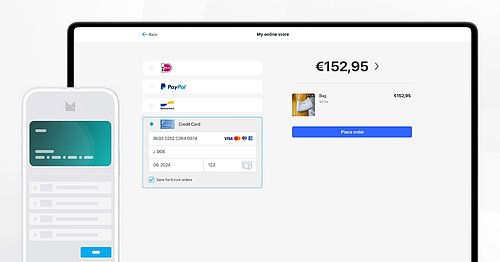How to prevent downtime and never miss a sale again
Even a few minutes of inactivity can be costly, resulting in lost sales and missed growth opportunities — not to mention the potential damage to your brand’s reputation.
At MultiSafepay, we support our customers in this area as well. As a payment partner with one of the lowest downtime rates in the market, we’re committed to helping merchants create seamless, and stress-free shopping experiences, both for the business and the end user. Many SMBs underestimate how even minimal downtime can affect revenue and customer trust, which is why our uptime performance is a key part of the value we deliver. We don’t just offer payment solutions; we offer peace of mind, allowing you to focus on growing your business while we take care of your uptime.
Given the complexity of this topic, this article provides an overview of the factors behind ecommerce disruptions and offers practical tips on how to prevent downtime. We’ll also show you the tools a reliable payment partner can offer to ensure you don’t lose a single sale.
The real impact of downtime on your business
Why do we place so much emphasis on avoiding even a single minute of downtime? Simple, because even brief outages can have a significant impact on your business. Here are just a few of the immediate and long-term consequences:
Loss of sales and drop in conversions: When your site goes offline, you lose every potential sale — even from customers ready to complete their purchase. A sudden interruption can deter customers who have already filled their carts, reducing the chances they’ll return to finalize their order. Frustrated by the experience, they may choose to buy elsewhere.
SEO penalties: Google and other search engines penalize websites with unreliable availability. This can lower your SEO ranking, reduce visibility and organic traffic, and negatively affect future sales.
Damage to brand reputation: Customers expect a smooth and reliable shopping experience. Frequent disruptions erode trust, making them more likely to turn to competitors.
Increased customer support load: Downtime often results in an influx of frustrated customers seeking answers. This puts additional strain on your support team and can slow down resolution times.
These challenges can significantly impact your performance and growth. That’s why minimizing downtime must be a top priority, and why choosing providers with proven uptime performance, like MultiSafepay, can make a measurable difference in long-term growth.
The hidden cost of payment downtime
What happens when a customer, after carefully selecting items and filling their cart, reaches the checkout page, only to experience a timeout or a declined transaction? Most of the time, the result is simple: cart abandonment and a lost sale.
Though harder to detect than a full site outage, payment downtime can be just as, if not more, damaging. Our experience shows that the payment stage is often the most critical part of the customer journey. A seamless payment process is key to building trust and closing sales.
When payment issues occur, not only do you lose that transaction, but customers may also question the reliability of your site, reducing the likelihood of future purchases.
At MultiSafepay, we understand how important this stage is. That’s why we offer solutions designed to prevent payment-related downtime. In fact, our downtime rate is among the lowest in the market — meaning fewer interruptions, higher trust, and more completed purchases for your business.
How we help you prevent downtime
As your growth partner, reducing downtime is a cornerstone of our mission — all to ensure a smooth, secure shopping experience for both you and your customers. Here’s how we help:
Acquirer and processor for major card networks: As both acquirer and processor, we control more of the payment flow than other providers. With direct connections to Visa, Mastercard, and Bancontact, we process transactions fully within our network, without relying on third parties. Fewer intermediaries means higher uptime, better transparency, and greater control for you.
We also optimize communication with card schemes to boost acceptance and conversion rates.Reliable infrastructure: Our infrastructure is built for high availability, a critical yet often overlooked factor for SMBs looking to scale reliably. We operate multiple data centers, enabling seamless failover in case of issues. Even if one center experiences problems, your payment systems stay online.
Real-time insights: Our merchant dashboard provides real-time data on payment performance, success rates, and potential anomalies — helping you detect and resolve issues before they affect customers.
Direct, responsive support: As your growth partner, reducing downtime is a cornerstone of our mission — all to ensure a smooth, secure shopping experience for both you and your customers. But beyond infrastructure, we also offer direct, responsive support from our in-house teams. So, when issues arise, you're not left waiting on third-party call centers — you get a fast, knowledgeable, human response that helps minimize downtime and protect your revenue.
With a reliable infrastructure and a proactive approach, you can strengthen customer confidence and deliver a standout shopping experience.
Common causes of downtime
Downtime doesn’t happen by chance — it usually stems from a combination of technical and operational issues. Here are some of the most common causes:
Hardware failures: Server malfunctions, such as broken components, faulty hard drives, or power supply issues, can completely take your site offline. These failures can delay page loading or cause full outages.
Software issues: Bugs in the code or failed software updates can interfere with your site’s functionality. Issues may range from product pages or payment gateways not loading properly to entire sections of the site becoming inaccessible. Keeping software up to date and thoroughly tested is critical.
Network malfunction: Network congestion, router failures, or firewall issues can prevent users from accessing your site. Traffic routing problems can be especially damaging during peak periods.
Traffic spikes: Sudden increases in traffic, due to seasonal events, sales, or marketing campaigns, can overload servers if your infrastructure isn’t scalable, leading to crashes and outages.
Human error: Even with the best technology, misconfigurations or mistakes during maintenance can result in downtime. A simple error can disrupt key site functionalities or even bring the whole site down.
Inefficient maintenance: While updates are essential, poorly executed maintenance can lead to unnecessary interruptions. Inadequate communication or failure to account for peak hours can result in avoidable downtime.
Cyberattacks: DDoS attacks or other malicious activities can overwhelm your servers and block legitimate users from accessing your site.
Payment gateway disruptions: Payment failures, such as timeouts, declined transactions, or authentication errors, are especially damaging. Shoppers reaching checkout may abandon their carts if they can’t complete the payment, resulting in both lost revenue and diminished trust.
Each of these causes presents unique challenges. Identifying them early helps you take proactive steps to reduce risk.
Downtime risk is closely tied to security. A secure and well-maintained site is essential for a positive customer experience and long-term loyalty. For more on this, check out our article on securing your store and ensuring happy, stress-free shopping — year-round.
MultiSafepay’s checklist for preventing downtime
As you’ve seen, preventing downtime goes beyond just the payment process. As a hands-on partner, we want to equip you with the tools and knowledge you need to safeguard every aspect of your business. Here’s what you can do:
Monitoring and alerts: Use real-time monitoring tools to track performance and detect anomalies. Enable alerts to respond quickly and prevent problems before they escalate.
Failover systems: Implement backup infrastructure and automatic failover systems. These allow your site to switch seamlessly to backups in case of failure, ensuring continuous service.
Regular testing and maintenance: Conduct load testing and vulnerability scans to ensure your systems can handle stress. Routine maintenance helps identify issues before they affect the user experience.
Incident response and communication: Have a plan in place. This includes clear internal procedures, effective customer communication, and strategies for maintaining trust during outages.
Stay informed with our status page: Subscribe to MultiSafepay’s status page to receive real-time updates on any service disruptions, whether on our platform or from our payment partners. Notifications are available via email, webhook, or SMS, and the service is completely free. It’s also a transparent way to see how rarely incidents occur.
With these practices in place, and MultiSafepay by your side, you can ensure your business remains resilient, even during challenging situations.
A frontline partner for your uptime
Uptime is a critical factor in the competitive world of online retail and becomes even more crucial during peak seasons. By choosing MultiSafepay, you get more than a payment provider: you gain a partner dedicated to your growth. Our scalable, modular, and sustainable solutions help you minimize downtime - a priority for SMBs, who may not always be aware of the hidden costs of even short service interruptions - protect your revenue, and deliver a smooth customer experience.
With MultiSafepay managing your payment systems, you can focus fully on growing your business — without worrying about missing a single sale.



